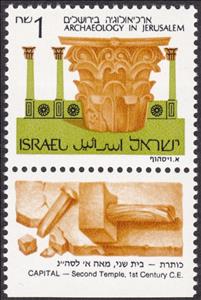Stamp with Collectible Margin: Corinthian Capital, 1st-Century BC (Israel 1989)
Corinthian Capital, 1st-Century BC (Israel 1989)
01 January (Israel ) within release Archaeology in Jerusalem goes into circulation Stamp with Collectible Margin Corinthian Capital, 1st-Century BC face value 1 Israeli new shekel
| Stamp with Collectible Margin Corinthian Capital, 1st-Century BC in catalogues | |
|---|---|
| Michel: | Mi: IL 1024yIT |
| Stanley Gibbons: | Sg: IL 982bT |
Stamp with Collectible Margin is square format.
Stamp with Collectible Margin Corinthian Capital, 1st-Century BC it reflects the thematic directions:
Archaeology or archeology[a] is the study of human activity through the recovery and analysis of material culture. The archaeological record consists of artifacts, architecture, biofacts or ecofacts, sites, and cultural landscapes. Archaeology can be considered both a social science and a branch of the humanities. It is usually considered an independent academic discipline, but may also be classified as part of anthropology (in North America – the four-field approach), history or geography
A temple (from the Latin word templum) is a building reserved for religious or spiritual rituals and activities such as prayer and sacrifice. It is typically used for such buildings belonging to all faiths where a more specific term such as church, mosque or synagogue is not generally used in English. These include Hinduism, Buddhism, and Jainism among religions with many modern followers, as well as other ancient religions such as Ancient Egyptian religion.


